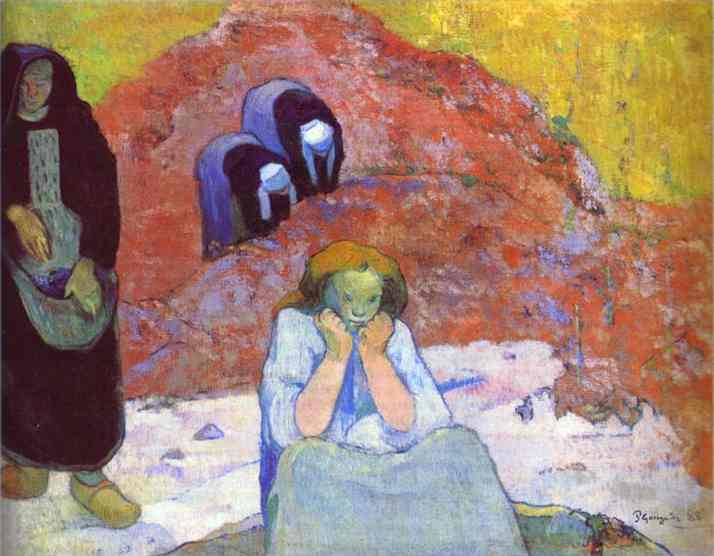Beskrivelse
Paul Gauguin's "Harvesting the Harvest at Arles" (1888) encapsulates a vibrant and vital moment of rural life in the south of France, where the artist settled during a crucial phase of his career. Painted in the context of his living with Vincent van Gogh, this work not only highlights Gauguin's distinctive technique, but also evokes the connection between humans and nature, a recurring theme in his work.
Gauguin depicts a grape harvest scene in a Mediterranean landscape, where the sunlight bathes the surroundings in a golden glow. The composition is set against a serene background, marked by a hillside covered with vines and lush vegetation that reinforces the idea of abundance in the harvest. In the foreground, the figures of two peasant women, dressed in traditional clothing, are diligently working to harvest the fruit. Their energetic and dynamic postures provide a sense of movement that contrasts with the calm landscape that unfolds behind them.
The use of color in this work is fundamental to understanding Gauguin's intention. He opts for a saturated palette, with vibrant greens and earth tones predominating, evoking the richness of the environment. The intense blues of the sky and the delicate yellow hues of the sun are contrasted by the purple tones of the grapes, creating a visual harmony that invites the viewer to feel part of this vital activity. The afternoon light seems to highlight not only the color of the grapes, but also the texture of the workers' skin, suggesting an intimate connection between humans and the land they cultivate.
The figures, although not individual portraits, represent the working women of the region. This choice by Gauguin is in line with his interest in the dignification of workers and the representation of everyday life. By portraying these women at work, the artist pays homage to local culture and agricultural tradition, a recurring theme in his work that seeks to elevate everyday life through art.
An interesting aspect of “The Grape Harvest in Arles” is its relationship to symbolism, a characteristic that would later further define Gauguin’s style. While this work reflects his interest in intense colors and rural life, one should not forget his choice of symbolic elements, which opens a dialogue about the spiritual and the earthly. The choice of the grape harvest, because of its association with wine and, therefore, with celebration and fertility, adds a level of depth that invites reflection on the meaning of human labor in contrast to the divine.
The work was painted at a critical moment in the artistic debate of the late 19th century, when the Post-Impressionist movements, including Gauguin and van Gogh, were beginning to challenge the conventions of traditional art. Both artists sought a purer essence of human experience through color and form, an attempt to capture the soul of the subject beyond its mere physical representation. "Harvest in Arles" is situated in this stylistic transition, where Gauguin begins to experiment with more simplified forms and bolder colors, preaching the way towards symbolism and modern art that would still influence later generations.
Ultimately, “Harvesting in Arles” is not simply a celebration of an agricultural activity. It is a testament to Gauguin’s encounter with a culture rich in traditions, a moment that captures the essence of country life and, above all, offers a reflection on the place of the human being in the cycle of nature. Through this work, Gauguin invites the viewer to join him in a meditation on work, life, and interconnection with the world before us – a narrative that continues to resonate deeply in the contemporary art world.
KUADROS ©, a famous painting on your wall.
Hand-made oil painting reproductions, with the quality of professional artists and the distinctive seal of KUADROS ©.
Painting reproduction service with satisfaction guarantee. If you are not completely satisfied with the replica of your painting, we will refund 100% of your money.

